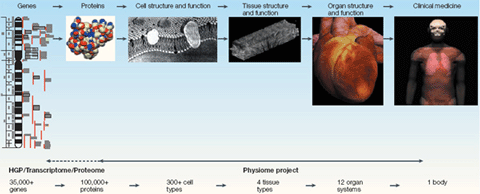|
"Form ever follows function".
Louis H. Sullivan (1856-1924)
Contemporary science has to adopt a new way of thinking,
which has emerged from rapid accumulation of knowledge
at different levels. By completing the "Book of Life" in
2003, one of the main challenges in physiology over the
next 10 years will be the interpretation of the genome
and ascribing physiological function to genes and
proteins in the wider context of integrative systems.
Human genome project, along with achievements in other
biological and non-biological sciences, has imposed a
paradigm shift in anatomy and physiology, necessitating
integration and linking across multiple scales of
biological organization - from proteins to cells,
tissues, organs and organ systems - in order to
understand a complexity of interactions between form and
function, generating a specific behavior (normal or
abnormal) in biological system (Physiome
Project).

Peter J. Hunter and Thomas K. Borg. Integration from
proteins to organs - the Physiome Project. Nature
Reviews 2003;4:237-243.
“Nature creates why, humans
find how. If how does not explain why, find another
how”.
Gerald D. Buckberg
During the last decade, three successive, international,
multidisciplinary symposia (Alicante
1995;
Bethesda 2002
and
Liverpool 2005) were
organized with common task - to set up fundamental
research principles, which would allow us to make a
significant step forward in understanding heart
structure and function.
Torrent-Guasp's HVMB has been widely studied as
anatomical model underlying electrical and mechanical
activity of the heart.
Below you may find recent review papers
describing current knowledge of HVMB physiology:
Torrent-Guasp F, Kocica MJ, Corno A, Komeda M, Cox J,
Flotats A, Ballester-Rodes M, Carreras-Costa F.
Systolic ventricular filling.
Eur J Cardiothorac Surg 2004;25(3):376-386.

Gerald D. Buckberg, Heinz Schelbert, Aman Mahajan.
Cardiac motion and fiber shortening: the whole and
its parts.
Eur J Cardiothorac Surg 2006;29:S145-S149.

Gerald D. Buckberg, Manuel Castellá, Morteza Gharib,
Saleh Saleh.
Active myocyte shortening during the ‘isovolumetric
relaxation’ phase of diastole is responsible for
ventricular suction; ‘systolic ventricular filling’.
Eur J Cardiothorac Surg 2006;29:S98-S106.

Gerald D. Buckberg, Manuel Castellá, Morteza Gharib,
Saleh Saleh.
Structure/function interface with sequential
shortening of basal and apical components of the
myocardial band.
Eur J Cardiothorac Surg 2006;29:S75-S97.

John P. Boineau.
Left ventricular muscle band (VMB): thoughts on its
physiologic and clinical implications.
Eur J Cardiothorac Surg 2006;29:S56-S60.

|